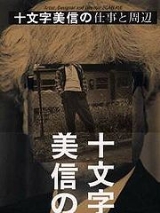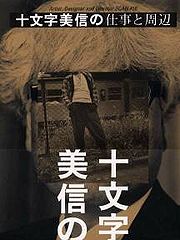
Bishin Jumonji
Encyclopedia

Jumonji was born in Yokohama
Yokohama
is the capital city of Kanagawa Prefecture and the second largest city in Japan by population after Tokyo and most populous municipality of Japan. It lies on Tokyo Bay, south of Tokyo, in the Kantō region of the main island of Honshu...
on 4 March 1947. After studying at the Tokyo College of Photography
Tokyo College of Photography
The was set up in Nakano, Tokyo in 1958, as Tokyo Photo School ; its current name dates from 1960. During the 1960s, it moved to Hiyoshi , where it has remained....
he worked as an assistant to Kishin Shinoyama
Kishin Shinoyama
is a Japanese photographer.Shinoyama graduated from Nihon University. He worked with the Light Publicity agency while still a student, and freelanced after graduation....
and went freelance in 1971, when he was the cameraman for advertisements for Matsushita Electric and Shiseido
Shiseido
is a major Japanese hair care and cosmetics producer. It is the oldest cosmetics company in the world and the fourth largest cosmetics company in the world.-History:...
products.
The association with Matsushita would later bring awards from the Art Directors Club every year from 1975 till 1979. Jumonji has continued to do editorial and commercial work (notably for Hayashibara Biochemical Laboratories); while much of this owes a lot to its art direction as well as photography, Jumonji's advertising work has been uncommonly ambitious and witty.
In 1972 he joined an exhibition of portraits (in Kinokuniya Gallery at Shinjuku
Shinjuku, Tokyo
is one of the 23 special wards of Tokyo, Japan. It is a major commercial and administrative center, housing the busiest train station in the world and the Tokyo Metropolitan Government Building, the administration center for the government of Tokyo.As of 2008, the ward has an estimated population...
) of Simon Yotsuya, with nine other photographers.
Jumonji had started taking his "Untitled" series of portraits of people framed to exclude their heads in 1971. In 1972, these appeared in the magazine Camera Mainichi
Camera Mainichi
is a Japanese monthly magazine of photography that started in June 1954 and ceased publication in April 1985.As in most mass-market photography magazines, much of the editorial content of Camera Mainichi was devoted to news and reviews of cameras, lenses, and other equipment...
and were shown in the Neikrug gallery in New York; a year later they were included within "New Japanese Photography", at the New York MoMA
Museum of Modern Art
The Museum of Modern Art is an art museum in Midtown Manhattan in New York City, on 53rd Street, between Fifth and Sixth Avenues. It has been important in developing and collecting modernist art, and is often identified as the most influential museum of modern art in the world...
.
Down till 1980, Jumonji made nineteen trips to Hawaiʻi
Hawaii
Hawaii is the newest of the 50 U.S. states , and is the only U.S. state made up entirely of islands. It is the northernmost island group in Polynesia, occupying most of an archipelago in the central Pacific Ocean, southwest of the continental United States, southeast of Japan, and northeast of...
, photographing the islands and photographing and interviewing elderly first-generation Japanese immigrants
Issei
Issei is a Japanese language term used in countries in North America, South America and Australia to specify the Japanese people first to immigrate. Their children born in the new country are referred to as Nisei , and their grandchildren are Sansei...
. The series counterposes color photographs of Hawaiʻi and black-and-white portraits of the people living there. Installments were published in Camera Mainichi in 1979 and the set was exhibited in 1980, when it won the Ina Nobuo Award
Ina Nobuo Award
The is given annually by the Nikon Salon, an organization of exhibition spaces in Japan that is sponsored by Nikon Corporation.The award was started in 1976; it is named in honor of Nobuo Ina, a photography critic who headed the Nikon Salon from 1968 until his death in 1978.The award is given to...
. It was published, as Orchid Boat, in 1981.
Jumonji's second published collection was Kéntauros, a large-format booklet of black-and-white photographs of the members of the motorbike organization Kéntauros (then a popular brand) striking macho poses with switchblades and other fashion accessories.
In 1981, Jumonji went to Indochina to photograph the religious customs of the Yao people
Yao people
The Yao nationality is a government classification for various minorities in China. They form one of the 55 ethnic minority groups officially recognized by the People's Republic of China, where they reside in the mountainous terrain of the southwest and south...
. In 1983–4 he visited Thailand, Burma and Laos. The result was published as Sumitōtta yami in 1987.
Jumonji had started photographing gold works of art in 1981. The first exhibition of the results was in Matsuya department store (Ginza
Ginza
is a district of Chūō, Tokyo, located south of Yaesu and Kyōbashi, west of Tsukiji, east of Yūrakuchō and Uchisaiwaichō, and north of Shinbashi.It is known as an upscale area of Tokyo with numerous department stores, boutiques, restaurants and coffeehouses. Ginza is recognized as one of the most...
), in 1987. This work culminated in the large and lavishly produced book Ōgon fūtenjin, published in 1990. This won the Domon Ken Award
Domon Ken Award
The Domon Ken Award is one of Japan's most celebrated photographic awards.The award was started in 1981 by the Mainichi Newspapers to mark the 110th birthday of the Mainichi Shimbun, its daily newspaper and main publication, in honor of the photographer Ken Domon...
the following year. Some of these works would also be shown in two of a set of four volumes of stereoscopes
Stereoscopy
Stereoscopy refers to a technique for creating or enhancing the illusion of depth in an image by presenting two offset images separately to the left and right eye of the viewer. Both of these 2-D offset images are then combined in the brain to give the perception of 3-D depth...
, all photographed by Jumonji and published in 1993–4.
Jumonji started photographing architecture and gardens in 1988, and specifically the Katsura Detached Palace
Katsura Imperial Villa
The , or Katsura Detached Palace, is a villa with associated gardens and outbuildings in the western suburbs of Kyoto, Japan...
in 1991.
Jumonji photographed Matsumoto Kōshirō IX
Matsumoto Koshiro IX
is a Japanese kabuki actor, one of the most popular tachiyaku currently performing.Like many members of the kabuki community, he can trace his lineage back several generations, many members of his family being kabuki actors as well...
for a collection of black-and-white portraits of the same title; he has recently published a second volume, Geki-gan, of monochrome portraits of actors taken with a large-format camera
View camera
The view camera is a type of camera first developed in the era of the Daguerreotype and still in use today, though with many refinements. It comprises a flexible bellows which forms a light-tight seal between two adjustable standards, one of which holds a lens, and the other a viewfinder or a...
shortly before or after performance.
In 1998, Jumonji started work on Wabi, his ambitious attempt at a depiction (in color) of the Japanese aesthetic ideal of wabi
Wabi-sabi
represents a comprehensive Japanese world view or aesthetic centered on the acceptance of transience. The aesthetic is sometimes described as one of beauty that is "imperfect, impermanent, and incomplete"...
. The project started with cha-no-yu
Japanese tea ceremony
The Japanese tea ceremony, also called the Way of Tea, is a Japanese cultural activity involving the ceremonial preparation and presentation of matcha, powdered green tea. In Japanese, it is called . The manner in which it is performed, or the art of its performance, is called...
but branched out into scenes of the quotidian.
Jumonji exhibited composite photographs of four Japanese waterfalls at the Shiseido Gallery (Ginza
Ginza
is a district of Chūō, Tokyo, located south of Yaesu and Kyōbashi, west of Tsukiji, east of Yūrakuchō and Uchisaiwaichō, and north of Shinbashi.It is known as an upscale area of Tokyo with numerous department stores, boutiques, restaurants and coffeehouses. Ginza is recognized as one of the most...
) in June and July 2004.
Jumonji's photographs have appeared in Zoom and Stern
Stern (magazine)
Stern is a weekly news magazine published in Germany. It was founded in 1948 by Henri Nannen, and is currently published by Gruner + Jahr, a subsidiary of Bertelsmann. In the first quarter of 2006, its print run was 1.019 million copies and it reached 7.84 million readers according to...
.
Books by Jumonji
Ran no fune / Orchid Boat. Tokyo: Tōjusha, 1981. The title alone is in English as well as Japanese. Kéntauros. Tokyo: CBS Sony, 1984. ISBN 4-7897-0132-8.- Sumitōtta yami. Tokyo: Shunjūsha, 1987. ISBN 4-393-33203-2
- Ōgon fūtenjin . Tokyo: Shōgakukan, 1990. ISBN 4-09-699371-9. Brief captions in English; all other text in Japanese only. Katsura rikyū . Nihon Mei-kenchiku shashin senshū 19. Tokyo: Shinchōsha, 1993. ISBN 4-10-602638-4. With text by Teiji Itō ( / Water Falls. Tokyo: Shiseidō Kigyō Bunkabu, 2004. A set of cards in a box, for the exhibition held in June and July 2004.
- Nippon gekigan / Nippon geki-gan: Dramatic portraits of actors and actresses. Tokyo: Pia, 2005. ISBN 4-8356-1578-6. Captions and most text in English as well as Japanese. Iru barusamiko / Il Balsamico. Tokyo: Kyūryūdō, 2007. ISBN 978-4-7630-0707-0. Photographs of the ModenaModenaModena is a city and comune on the south side of the Po Valley, in the Province of Modena in the Emilia-Romagna region of Italy....
area and the production of balsamic vinegarBalsamic vinegarBalsamic vinegar is a condiment originating from Italy.The original traditional product , made from a reduction of cooked white Trebbiano grape juice and not a vinegar in the usual sense, has been made in Modena and Reggio Emilia since the Middle Ages: the production of the balsamic vinegar is...
. Kansei no bakemono ni naritai / Beyond the Senses. Tokyo: Kyuryudo Art Publishing, 2007. ISBN 978-4-7630-0730-8. Over five hundred pages long, this is a chronological survey of Jumonji's work.
Others
- Matsuoka, Seigow (}, Matsuoka Seigō). Yūkō no hakubutsugaku . Tokyo: Shunjūsha, 1987. ISBN 4-393-33109-5. Jumonji contributes a number of photographs for chapter 5, about gold works of art.
- Szarkowski, JohnJohn SzarkowskiJohn Szarkowski was a photographer, curator, historian, and critic. From 1962 to 1991 Szarkowski was the Director of Photography at New York's Museum of Modern Art.-Early life and career:...
, and Shoji YamagishiShoji Yamagishiwas a photography critic, curator, and magazine editor.Yamagishi entered Mainichi Shinbunsha in 1950. He started as a photographer, but was less successful at taking than at selecting photographs....
. New Japanese Photography. New York: Museum of Modern Art, 1974. ISBN 0-87070-503-2 (hard), ISBN 0-87070-503-2 (paper). This includes a single photograph from the "Untitled" series.
External links
Official site (requires Flash)- Water Falls the 2004 exhibition Sumitōtta yami This article by Seigow Matsuoka ranges further than the one book, and has sample photographs.

